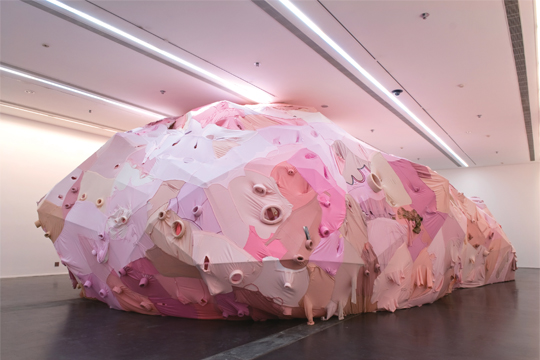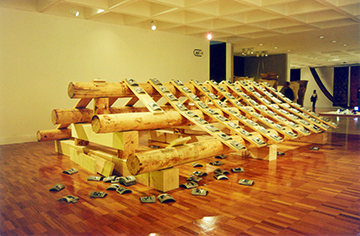YIN XIUZHEN: NOWHERE TO LAND
| December 19, 2013 | Post In LEAP 23

NICOLAS BOURRIAUD HAS drawn on botanical concepts in order to define aesthetic characteristics in a globalized context, as distinguished from the extreme modernist “radical” tradition. In their pure pursuits, their thirst for the establishment of a new order, and their infatuation with the roots of “l’essence,” practitioners of contemporary art frequently adopt a kind of “radicant” posture in order to participate in their historical context. Creative activities no longer rely on having their roots in a particular soil; through ceaseless self-transplantation, translation, and the radicant attitude of the global immigrant, they are putting down roots everywhere, under the premise of facing up to a sense of belonging within a community, as well as through an active relationship with a constantly shifting geological environment. “Nomade” and “errant” are symbols of such radicant attitudes. However, attitudes that claim to simultaneously break away from the restrictions of the rhizome and embrace the freedom of radicants must also bear the sense of division inherent in an errant state, as well as an anxiety of indeterminate source.
“Nowhere to Land,” the title of Yin Xiuzhen’s solo exhibition at Pace Beijing in the summer of 2013, is more an accurate description of her creative state over the years than it is the title of any one work or exhibition. Along with many other Chinese artists who were born during the Cultural Revolution and began their professional careers at the start of the 1990s, Yin’s personal life and creative work have been affected by the shaking tectonic plates of that era. The Communist utopian dream and warm collective memories of the era in which she matured had barely been wrapped up and locked away when the mad tide of globalization and the new liberal economy came to sweep everything away in its wake, a transformation so swift and drastic that it left no chance to catch one’s breath. “Nowhere to Land” represents the direct examination of a nomadic existence against the backdrop of a series of violent changes to China’s social reality and a life of constant migration, as well as the anxiety and impetus for growth released within a myriad of drifting, fragmented moments.
It is worth noting that this otherwise inexpressible force and mood in Yin Xiuzhen’s art does not seek to envelop its audience through a top-down, compulsive approach; instead, a kind of omnipresent intimacy leaks from each tiny corner, weaving itself into a fine net brimming with tension. But we cannot simply label such important characteristics of her work as “feminist,” as they are founded on the relationship between the artist (not just the female artist), her life, and her practice. Here, methodology is a stronger contributing factor than gender identity. Surrounded by Yin’s work, the audience never feels that the art represents something unattainable or out of reach, but neither are they able to reject the sense of mystery and enchantment that the artworks emit, dragging them towards some far-off power. The artworks created through the modification of objects or settings from ordinary life maintain a constant state, which both remains attached to the real world, and is anxious to escape from it. This does not stem from the sort of aesthetic manifesto that aims to break the boundaries of art and life; rather, it is attributable to the artist’s own position in the world. In my opinion, Yin has never deliberately set out to transform the relationship between everyday experience and the production of art; she is simply exposing the self between these two sides and letting their effects on her own power intersect through creative activity. Through a constant attitude of growth, the self is placed unreservedly within the truth of life and the mystery of creation. This explains Yin’s unusual sensitivity to the texture of reality, as well as the way in which this sensitivity pervades her art: genuine as taking a breath, exquisite with texture and tension. In this sense, attempting to understand Yin’s artwork from a feminine viewpoint alone is insufficient. In fact, a logic which is far more accessible than “female thought” exists in her creative work: as an artist who produces her artworks through the construction of abstract aesthetic structures, Yin always extracts emotional material (experience, memory, imagination, introspection, and so on) directly from the subtle details of her individual experience; she immerses herself in an environment which resembles a massive reality machine, which, through the ceaseless collision and extrusion of the individual, drives the artist’s desire to express and release said material. In the process of accumulating this personal experience and seeking a suitable linguistic channel for its release, the artist constructs her own creation ecosystem.

This system is not known for its complexity or obscurity; at least from the cognitive plane, audiences can easily grasp the
codes or channels frequently accessible in Yin Xiuzhen’s work: personal items, cities, suitcases, planes and automobiles, textiles, everyday objects, individual memories, or the collective subconscious. However, these familiar, snapshot-style terms are not enough, in my opinion, to offer a more deep-seated, rich understanding of Yin’s creative system. Here I attempt to seek out another channel: the objectification that takes place within her artwork, and the driving force behind its explanatory code. To a certain extent, it is similar to Henri Bergson’s “élan vital,” the force that drives an artist’s creativity and the diversity of their work within the Flux de L’expérience. In fact, beginning with Dress Box, The Doors, and Cement Shoes, all of which date from the mid-1990s, Yin’s artworks have consistently displayed a high degree of sensitivity and a unique interest in “objects.” Her early objects drew on memory and experience, and through appropriation and transformation became altogether different objects; they retained, or at least half-retained, their original material characteristics but had already started to deviate from standard, not exactly as a primary goal, but as a continuous, unconscious driving force behind her creative actions……( Continue to read in LEAP 23 )

